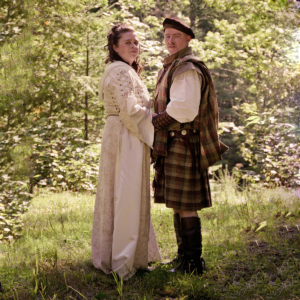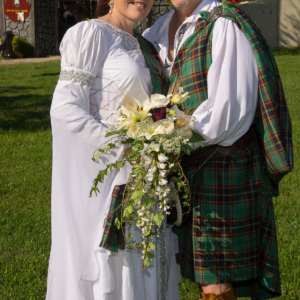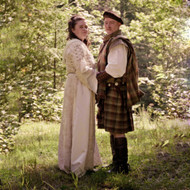What is the History of the Kilt?
Posted by The Celtic Croft on Dec 23rd 2019
We are all familiar with the article of clothing known as the kilt. What we are probably less familiar with, on the other hand, is the origin and history of the kilt. Part of the reason for this is no one truly knows the exact source of this distinct clothing style.
Ultimately, it depends on who you ask. If you ask an Irishman, they will definitively tell you that the kilt is an Irish adornment that was brought from Ireland to Scotland. The Scottish will say to you that this is ridiculous, and the kilt belongs to Scottish culture and is only adopted by the Irish later.
If you ask an Englishman, you are liable to hear that an Englishman, Thomas Rawlinson, was the original inventor and wearer of the modern kilt. Which one of these claims is true, it is hard to say.
One sure thing, though, is that the kilt is considered the national dress of Scotland. In that regard, the origins of the garment are not essential to determine; but let’s try anyway.
At The Celtic Croft, we specialize in all things Celtic. We have one of the largest selections of kilts, tartans, and accessories on the internet. To us, family is the most important thing, and we treat all our customers like family.
The History of the Scottish Kilt

The Infamous Braveheart Kilt?
The Scottish tartan kilt is one of the most recognizable national dress items in the entire Western world. The image is tied to romance, adventure, and, let’s face it, Braveheart. Although the Scottish people often wish that the last one would go away.
If you ask any Scotsman, they will be compelled to tell you all the ways that the movie got it wrong, with regards to kilts, that is. It’s not all Braveheart’s fault, though. The idea existed long before it, and the movie just capitalized on an already existing notion. It is possible to find Braveheart kilts, however.
You will see it at any Renaissance Faire you attend, men in kilts who assume, because they were led to believe by common knowledge, that the kilt was a medieval garment. This myth is a popularly held one, but it is, unfortunately, false.
Ancient Kilt

The first mentions of anything resembling a modern kilt come from writings dated back to the 16th century. In reality, these writings were mentioning a feilidh-mor or great wrap, or sometimes called an ancient kilt. Alternatively, they could have been writing about another famous Scottish dress, the breacan-feile, or tartan wrap.
These names can often be considered interchangeable. Both are describing a length of heavy, patterned fabric, traditionally wool, that is worn folded over the body like a shawl or mantle.
A kilt, on the other hand, is what is traditionally known as a belted plaid. To wear it, the intended wearer would lay down on the cloth, then pleat it down the middle section, and finally, wrap it around his or her body with a sturdy belt. It’s not a naturally smooth motion, and it might take some practice for the newer kilt wearer to get it right.
The kilt began as a more functional item than a fashionable one. The kilt often doubled as a blanket, which is why the wearer would typically dress from a prone position; he was already down there.
Mentions of the Kilt in Literature

The first mention in early writings of anything that we may take as a kilt or belted plaid does not appear until 1578. A Bishop named Lesley wrote about the Scottish people and the mantles they wore. He said that all the people, regardless of rank or station, could be seen with long and flowing garments that could be gathered neatly into folds.
This mantle may very well have been early versions of the modern kilt we all know so well. He never mentions a belt, though, so it is unlikely that he is talking about the idea of a belted plaid.
The kilt is mentioned again in another writing around the same time. In 1582, in his book called ‘The History of Scotland,’ George Buchanan details a tightly woven woolen length of cloth that is worn during the day and used as a blanket at night. He also mentions the striped cross patterns that signify family lines.
He goes on to talk about the ruggedness of the Highlanders. They were known to be stout men, who braved heavy storms and snows with little protection. They were known to lie down in the snow in their kilts when they had to.

But the firmest proof comes from a document penned in 1594. An Irishman, Lughaidh O’Clery, writes about a group of Scottish mercenaries from the Hebrides who was employed by Red Hugh O’Donnell.
This document also may be taken as proof that the kilt is a Scottish invention. O’Clery states that the Scottish men could be recognized among the Irish by the difference in their dress. Of course, their speech and habits were different as well, but O’Clery points to their arms and clothing as separate and strange to the Irish.
He writes that the Scottish mercenaries wore mottled cloaks that extended to the calf of their legs, and they wore girdles outside of their wraps.
Note the mention of the girdle, or belt. This is the hallmark of the modern-day kilt or belted plaid. Without the belt, you can’t be sure it’s a kilt.
So What Do We Know?
We cannot know the exact origins of the kilt, as we can only study the writings that have survived. It is entirely possible that Irish or Scottish people were wearing styles similar to the belted kilt and that the knowledge of such practices has been lost to the ages. We can only go by what we have recovered.
The one thing we do know is that the kilt is strongly tied to the Scottish heritage. You will still find people wearing them all over Scotland. One of the reasons this mode of dress has survived and thrived so well is the fact that the Scottish people have allowed it to change and evolve as they do.
You will see kilts dressed up in traditional regalia as much as you will with a t-shirt and sandals today. The kilt is a part of the Scottish zeitgeist, and the only thing many Scots will agree on is what should be worn underneath, namely nothing!
If you are looking to add a kilt into your wardrobe, consider The Celtic Croft to expand your education. We have anything you could ever need to incorporate this venerated garb into your daily dress or even a special occasion.

